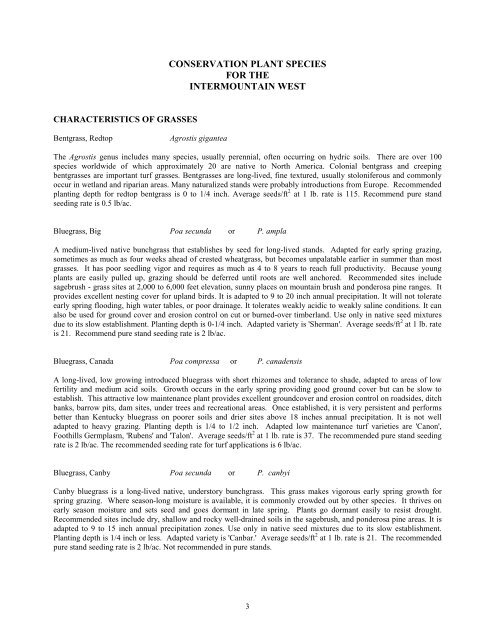Idaho Plant Materials Technical Note No. 24
Idaho Plant Materials Technical Note No. 24
Idaho Plant Materials Technical Note No. 24
Create successful ePaper yourself
Turn your PDF publications into a flip-book with our unique Google optimized e-Paper software.
CONSERVATION PLANT SPECIES<br />
FOR THE<br />
INTERMOUNTAIN WEST<br />
CHARACTERISTICS OF GRASSES<br />
Bentgrass, Redtop<br />
Agrostis gigantea<br />
The Agrostis genus includes many species, usually perennial, often occurring on hydric soils. There are over 100<br />
species worldwide of which approximately 20 are native to <strong>No</strong>rth America. Colonial bentgrass and creeping<br />
bentgrasses are important turf grasses. Bentgrasses are long-lived, fine textured, usually stoloniferous and commonly<br />
occur in wetland and riparian areas. Many naturalized stands were probably introductions from Europe. Recommended<br />
planting depth for redtop bentgrass is 0 to 1/4 inch. Average seeds/ft 2 at 1 lb. rate is 115. Recommend pure stand<br />
seeding rate is 0.5 lb/ac.<br />
Bluegrass, Big Poa secunda or P. ampla<br />
A medium-lived native bunchgrass that establishes by seed for long-lived stands. Adapted for early spring grazing,<br />
sometimes as much as four weeks ahead of crested wheatgrass, but becomes unpalatable earlier in summer than most<br />
grasses. It has poor seedling vigor and requires as much as 4 to 8 years to reach full productivity. Because young<br />
plants are easily pulled up, grazing should be deferred until roots are well anchored. Recommended sites include<br />
sagebrush - grass sites at 2,000 to 6,000 feet elevation, sunny places on mountain brush and ponderosa pine ranges. It<br />
provides excellent nesting cover for upland birds. It is adapted to 9 to 20 inch annual precipitation. It will not tolerate<br />
early spring flooding, high water tables, or poor drainage. It tolerates weakly acidic to weakly saline conditions. It can<br />
also be used for ground cover and erosion control on cut or burned-over timberland. Use only in native seed mixtures<br />
due to its slow establishment. <strong>Plant</strong>ing depth is 0-1/4 inch. Adapted variety is 'Sherman'. Average seeds/ft 2 at 1 lb. rate<br />
is 21. Recommend pure stand seeding rate is 2 lb/ac.<br />
Bluegrass, Canada Poa compressa or P. canadensis<br />
A long-lived, low growing introduced bluegrass with short rhizomes and tolerance to shade, adapted to areas of low<br />
fertility and medium acid soils. Growth occurs in the early spring providing good ground cover but can be slow to<br />
establish. This attractive low maintenance plant provides excellent groundcover and erosion control on roadsides, ditch<br />
banks, barrow pits, dam sites, under trees and recreational areas. Once established, it is very persistent and performs<br />
better than Kentucky bluegrass on poorer soils and drier sites above 18 inches annual precipitation. It is not well<br />
adapted to heavy grazing. <strong>Plant</strong>ing depth is 1/4 to 1/2 inch. Adapted low maintenance turf varieties are 'Canon',<br />
Foothills Germplasm, 'Rubens' and 'Talon'. Average seeds/ft 2 at 1 lb. rate is 37. The recommended pure stand seeding<br />
rate is 2 lb/ac. The recommended seeding rate for turf applications is 6 lb/ac.<br />
Bluegrass, Canby Poa secunda or P. canbyi<br />
Canby bluegrass is a long-lived native, understory bunchgrass. This grass makes vigorous early spring growth for<br />
spring grazing. Where season-long moisture is available, it is commonly crowded out by other species. It thrives on<br />
early season moisture and sets seed and goes dormant in late spring. <strong>Plant</strong>s go dormant easily to resist drought.<br />
Recommended sites include dry, shallow and rocky well-drained soils in the sagebrush, and ponderosa pine areas. It is<br />
adapted to 9 to 15 inch annual precipitation zones. Use only in native seed mixtures due to its slow establishment.<br />
<strong>Plant</strong>ing depth is 1/4 inch or less. Adapted variety is 'Canbar.' Average seeds/ft 2 at 1 lb. rate is 21. The recommended<br />
pure stand seeding rate is 2 lb/ac. <strong>No</strong>t recommended in pure stands.<br />
3
















